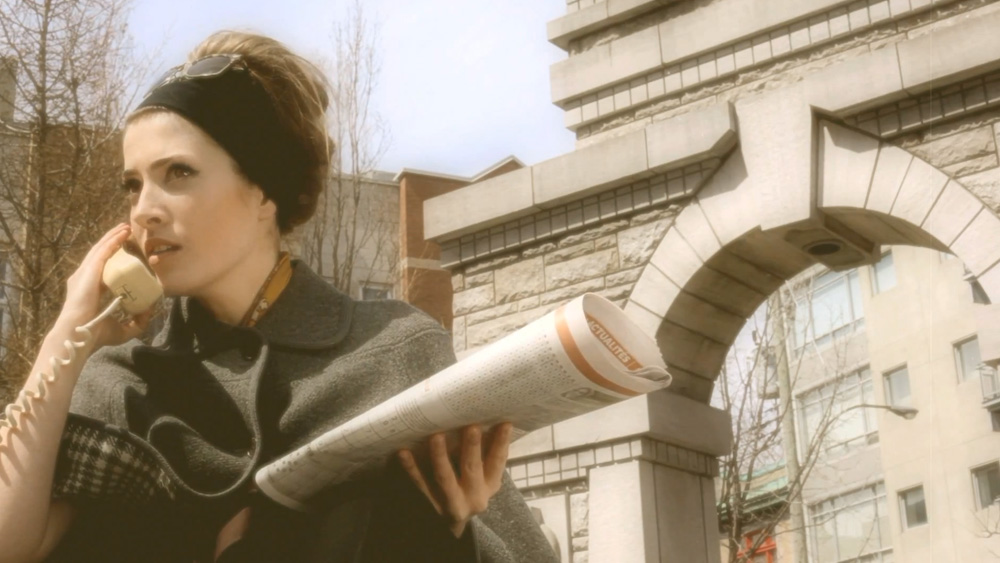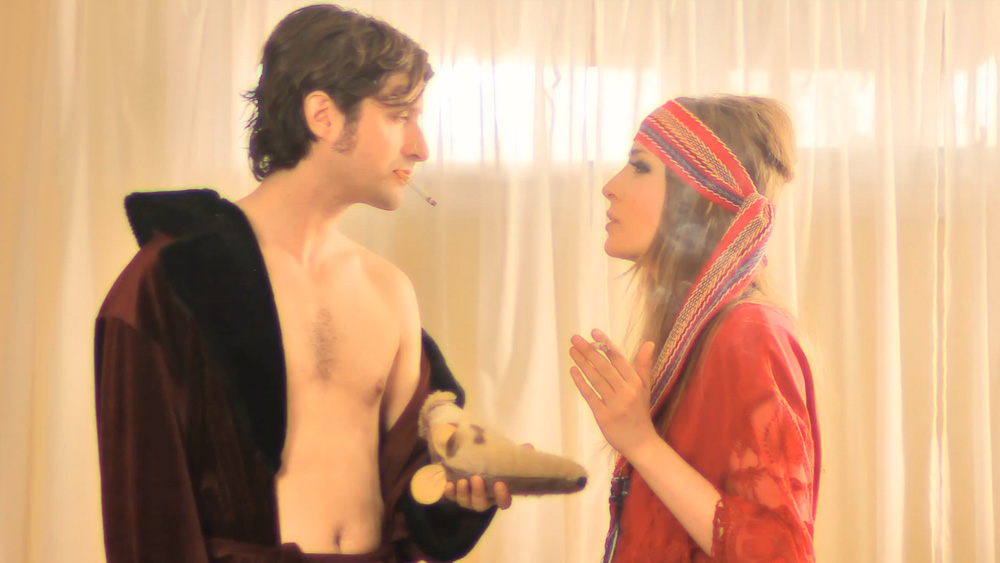In the middle of a settling of scores, two dangerous thugs must face the demons of a life on the edge, whose law makes no distinction between victims and executioners.
Mirko Frezza (Matteo Garrone’s “Dogman“) stars in this experimental noir that explores the dynamics of a criminal mind.
Mascagni’ Symphony is a set of spin-off of a feature film screenplay composed of cursed stories about outsiders and lowlifes, portrayed with different narrative keys. The described world is inspired by outskirts’ news reports, finding its cinematic expression through poetic imagery. The stories are set around a street called Pietro Mascagni, north of Milano, hence the idea to pay tribute to the composer by giving to the short films the tone of classical opera.
Inno all’Infamia (Hymn to Infamy), the first episode of this collection is a monologue with a tricky narrative structure that aims to be an incipit rather than a proof of concept. We spoke to brothers Alessandro (director) and Flavio (writer) Vivarini who gave us a little more insight on the film.

What was the inspiration behind “Mascagni’s Symphony: Inno all’Infamia”? Can you tell us about the creative process that led to the development of this experimental noir?
Alessandro:
My brother and I have several feature film concepts in our drawer. Among them, one particularly revolves around the criminal underworld, the outcasts and those without hope, closely tied to the areas where we grew up. We decided to shoot some spin-offs of this story, gathered in a short film series called “Mascagni’ Symphony”. These shorts aimed to show the cinematic style we envisioned for our larger project.“Inno all’Infamia” serves as the inaugural chapter of this series. It was designed for an agile production process that would grant us maximum creative freedom on a visual level. My brother, Flavio, crafted a stream of consciousness script that is irrational, instinctive and poetic at the same time. Through this approach, we tried to illuminate the contradictions and hypocrisies that pervade a world fueled by the allure of power, ultimately leading to a moral downfall.
On the visual front, I had the opportunity to infuse rich symbolism and employ techniques that embody the distinctive style we strive to cultivate. This short film can be seen as a visual manifesto, encapsulating our artistic vision and serving as a captivating introduction to our narrative world.
“Mascagni’s Symphony” explores the dynamics of a criminal mind. Can you elaborate on how the film delves into this theme and what aspects of the criminal mind it aims to capture?
Flavio:
With “Inno all’Infamia”, I wanted to expose the philosophy of our protagonist, that is inherently hypocritical and contradictory, yet finds justification within the criminal underworld. Within this context, concepts like honor and respect are not only stripped of their true essence but are completely twisted.Through a carefully crafted monologue, my brother Alessandro and I aimed to lead the audience on an intimate journey, a descent into the depths of hell. Our intention was not simply to tell a story, but rather to strike at the core, exploring the ambitions, hatred, and thirst for revenge that drive a profoundly disturbed psyche.

The film features Mirko Frezza, known for his role in “Dogman.” How did his performance contribute to the portrayal of the dangerous thugs and their inner demons?
Flavio:
Mirko Frezza, in addition to his immense talent, has an incredible redemption story, encompassing a journey from a challenging past to a bright and successful present (his inspiring journey has been documented widely online). So, when Mirko shared that he felt a deep personal connection to the monologue, relating it to his own experiences and those of many people he knows, we had confirmation of how much our story needed to be told.
In terms of his performance, every aspect, from his expressions to his physicality and overall approach, contributes significantly to portray the environment we aimed to depict. Mirko’s eyes, in particular, serve as a window into the haunting depths of certain individuals’ souls, encapsulating the notion that some demons are more fearsome than others.
The title “Inno all’Infamia” translates to “Hymn to Infamy.” What does this title signify in the context of the film, and how does it relate to the exploration of the blurred line between victims and executioners?
Flavio:
The protagonist begins his monologue with the line ‘There is no success without shame’, which serves as a warning about the absurd reversal of values within the criminal environment we discussed earlier. Betrayal itself is deplorable and insidious, but not in this context, not when justified by the thirst for power and the pursuit of a specific goal. Dedicating an ‘hymn’ or ‘ode’ to the epitome of human indignity, namely infamy, presents a profound contradiction and reveals the deeply diseased and corrupted nature of the depicted reality. It evokes a sense of fear and serves as a commentary on the dark forces at play.Furthermore, the exploration of the blurred line between victims and executioners is exemplified in the feud among the three characters, who all embrace the ambiguous philosophy expressed in the monologue. The act of cutting the tongue of one character as punishment for betrayal is followed by a more heinous act committed by another character, who shoots the first one in the back, eliminating him as an obstacle to his own grandiose ambitions. This sequence showcases the triumph of infamy in its various forms, presenting a raw yet theatrical representation of the twisted moral compass that drives the characters.

“Mascagni’ Symphony” is described as an experimental noir. Can you discuss some of the experimental elements employed in the film and how they enhance the narrative or thematic elements?
Alessandro:
We played extensively with the narrative technique of stream-of-consciousness. Our deliberate choice to withhold the narrator’s identity until the final frame serves to suggest the cyclical and redundant nature of that universe. The young criminal follows the same path as the older one, with the same attitude and mentality, so whether it is one character or the other speaking becomes irrelevant.Our aim was not merely to tell a linear story, but to evoke a particular sensation and expose the inherent failure of a violent system that rationalizes its actions in the name of distorted ideals. By challenging traditional narrative conventions and infusing the film with a more psychological approach, we tried to authentically represent the contradictory nature of this world.
Could you tell us about the visual style and cinematography of “Mascagni’s Symphony”? How do these elements contribute to the overall atmosphere and mood of the film?
Alessandro:
Visually, we aimed to enhance the narrative and engage the viewer on a gut level. This led us to incorporate religious symbolism, the dilation of time during violent moments, and glimpses of demons. We also wanted to emphasize the concept of values being overturned, creating a sense of ‘upside down’. An example of this is the 180-degree rotation culminating in a reflection, as well as the burning crucifix where the flames appear to run from top to bottom. These elements aim to resonate on an irrational level.For the cinematography, we entrusted our dear friend and talented professional, Andrea Donadoni, to translate our vision into raw lighting that intensifies color contrasts in crucial moments. We had this idea of descending into hell, which inspired us to use vibrant red tones in contrast with shadows to create a specific atmosphere.
Music can often play a crucial role in enhancing the cinematic experience. What role does music play in the short film? How does it interact with the narrative and themes?
Alessandro:
To me, music speaks louder than visuals. The concept of naming our project “Mascagni’ Symphony” originates from our upbringing in a small neighborhood bearing the name of the famous composer. Hence, the concept of incorporating different excerpts from his works in each short film of the series. “Inno all’Infamia” opens with the intermezzo from the opera “L’Amico Fritz”, a grand and solemn melody that effectively conveys the monologue’s sense of inevitability.The remainder of the musical landscape, which I personally crafted, primarily consists of adapted hardcore techno elements tailored for cinematic purposes, along with samples from gangsta rap artists. This edgy sonic approach adds a raw and direct quality, forming a distinct contrast with the classical music. I find it very inspiring to explore this formula.
Were there any specific challenges or interesting moments during the production of “Mascagni’s Symphony”? How did you overcome those challenges, and how did they shape the final product?
Alessandro:
The most challenging aspect during the production was managing the location. The abandoned parking lot seemed to be shared with several buildings, and it was never entirely clear. We had authorization from one owner, but the other strongly opposed making any noise during the restaurant’s opening hours within the facility. Of course, the scene we had to shoot multiple times was the one where Mirko Frezza fires at my brother! The reverberation was huge. We were afraid that someone would call the police, but luckily, everything turned out fine in the end.The real challenge, however, was juggling multiple roles due to the low-budget nature of the short film. We had to fulfill all the professional responsibilities that were missing in the credits, which naturally extended the timeline.
What do you hope viewers will take away from “Mascagni’s Symphony: Inno all’Infamia”? Are there any specific emotions, thoughts, or discussions you want to evoke with this film?
Flavio:
We aim to deeply affect the viewers. Our intention is to disturb them, to challenge their indifference and provoke them to form strong and decisive opinions, regardless of whether they are positive or negative. Throughout the production process, we were aware that, given the experimental nature of our film, it might not be easily palatable. However, we take great pride in its authenticity, and our hope is that the deliberate disruption caused by the subversion of values we have depicted elicits a powerful response – whether it be disgust, discomfort, fascination, or exhilaration. I genuinely mean it.Furthermore, we aspire for the viewers to recognize the distinctiveness of our stylistic approach. We believe that we have accomplished remarkable work (considering our limited resources), fusing influences from Catholicism and Caravaggio with the realm of the criminal underworld precisely within the setting we aimed for. We strove for a technically proficient presentation, an aspect on which we were unwavering.
Can you share any future plans for the film, such as festival submissions or potential distribution? Are there any upcoming projects you would like to highlight?
Alessandro:
The short film has successfully concluded its festival journey, and we have recently made it available for online viewing. At present, we are in the final stages of production for our upcoming short film, which is part of the “Mascagni’ Symphony” series. Titled “Idillio all’Inferno”, it delves into the complex dynamics of a father-daughter relationship within the backdrop of addiction. We are excited to have enlisted the participation of another immensely talented Italian actor and a young, exceptionally gifted artist, along with our trusted team of collaborators.
Finally, what are you favorite short films?
Alessandro:
Hard to say, as I find short films from various genres to be interesting. One that stands out to me, among the classics, is “Glory at Sea” by Benh Zeitlin. I was dazzled by its unique narrative perspective. It’s fascinating how it strikes you at the core. Truly epic.




